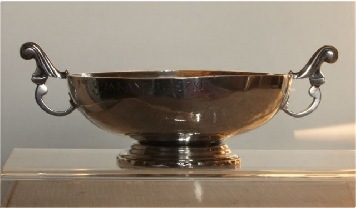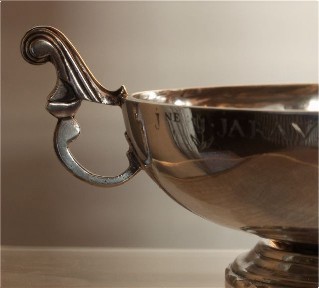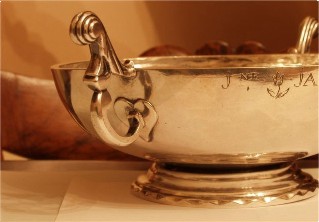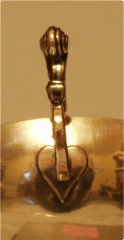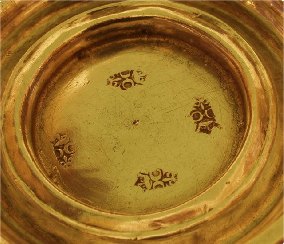click on images to enlarge
THE HISTORY OF A WEDDING CUP
(TASSE DE FEMME)
|
The beautiful history of Jeanne Jaravel
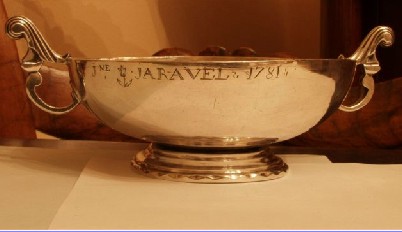 |
There was a lot of merriment that day in Fixin in the Clos de la
Perrière. The whole Jaravel family was reunited to celebrate the
nuptials of Jeanne Jaravel with the Sieur Hugues Arvelin, viticulturist
in Gevrey-Chambertin. (1)
The Clos de la Perrière is a very old vineyard, not very big
where the first grapevines were planted between 1102 and 1142 by the
monks of Citeaux and belonged to the Jaravel family for several
generations.
In the Bourguignons (2) villages, people were saying that the crop was
full of promise. The gathering of the grapes was terminated after a long
month.
They were already finished with the pulling and breaking up of the
vines. The grounds were cleaned around the old roots and parasites
removed. The new roots were now in a vegetative rest and the leaves
started to show superb shades of red and gold. All the village was
present at the door of the Chapel Saint Vincent. Everyone was
happy on this October morning.
The temperature was mild and a light fog was covering the vine stock
from the Clos as to protect them from the sun rays, which were very
welcomed in the autumn season.
Jeanne was 20 years old and the only daughter of Michel Jaravel and
Sylvie Esmolin, viticulturist and owner of the Clos de la Perrière.
She had met Hugues Arvelin during the Chandeleur holiday at the
home of Charon in Beaune. The preparations for the wedding started in
the spring on the 20th of May 1781. Michel Jaravel left in a diligence
for Trevoux where Dominique Chantel, silversmith, was waiting for him on
the Rue de l'escalier (3).
After a long day, he arrived in Trevoux and entered the door of the
store of the Silversmith Chantel to choose a silver cup with handles
that he would offer to his daughter on the occasion of her marriage.
His choice was a simple, elegant cup mounted on a molded stand. The two
handles of the cup were in the shape of leaves and bonded to the cup by
two hearts.
The other cups in the store did not have this distinction so his
decision was firm. This cup looked very much like the one stamped by the
master silversmith Denis Nesme of Lyon, friend of her father and that
his wife Sylvie received for her marriage in 1756.
Michel Jaravel wanted to continue the tradition and was happy to be able
to do so.
He asked Dominique Chantel to stamp the name of his daughter and also
the year of the wedding. He went with the silversmith to engrave "J ne
JARAVEL 1781" on the cup and added a small flower between the first and
last name. This was common in that part of the country and the
silversmith felt that in a small way, he had participated in the
festivities.
Raoul C VERBIST December 23, 2002
Often called "Lady's cup" in the inventory, the cup with two handles
called "cup bourguignonne " (2) is called "wedding cup" today.
At the end of the 17th century, it was customary to offer the couple a
cup on a low base with two vertical handles mounted with crosses or
animal heads, real or fantasy.
The exterior of the cup almost always had the name of the bride and the
date of the marriage. After the ceremony in church, the couple would
drink from the cup they would keep for the rest of their lives, like a
precious trinket. Sometimes it would be used after the birth of a child,
with bread soaked in wine for the mother.
The silversmiths from Dijon and Morlaix were specialized
in the production of these cups.
Nowadays, the original use of the drinking cup is lost; it is used
mostly as a tray to empty your pockets and sometimes as a gift for
anniversaries.
This type of cup has lasted from the Middle Ages to the beginning of the
19th century with differences in the shape of the handles or the base.
Most of the wedding cups were made in Bourgogne and Bretagne (2) until
the middle of the 19th century. The oldest example found goes back to
the end of the 17th century.
The model of the cup doesn't change much until the beginning of the 19th
century; only the shape of the handles indicate the chronology and
origin.
During the years 1680-90, we see handles with pearls. The shape of the
handles with a dolphin appears at the beginning of the 18th century and
lasts until the end of the Ancient Regime, without notable changes
between 1720-1780.
In the year 1780 until the beginning of the 19th century, the handles
are decorated with foliage and become unique in Bourgogne (2) during
these years.
The two handled cups are generally of very good quality and
aesthetically elegant in their simplicity.
translator's notes:
(1) viticulturist is an expert in raising grapevines
(2) Bourguignon is a person from the French province of La
Bourgogne and Bretagne. If you deal a lot with antiquities, you need to
know the names of the French provinces.
(3) Rue de l'escalier is the name of a street
STUDY OF A WEDDING CUP MADE BY SILVERSMITH
DOMINIQUE CHANTEL OF TREVOUX
Silversmith :
CHANTEL Dominique
1725-1788
silversmith in Trévoux
(active from 1759 to 1788)
Born in Thurins-sur-Rhône
Authorized by parliament in November 26, 1759 to pratise silversmithing
in Trévoux.
He takes his oath in front of the Officiers de la Monnaie of Lyon
on September 14, 1785 and engraves a new hallmark.
He died in Trévoux on March 22, 1788, at the age of 63.
hallmarks : DC, a fleur de lys, a crown above (1759), a C with a crown
and a fleur de lys below (1786)
Sources : A.D. Côte d'Or (B 1194,6; A.D.), Rhône
(6B 325)
Bibliography : Godefroy 1965, p. 334-335
L'Orfèvrerie de Lyon et du Trévoux
Known works :
Tray 1759-1771 (private coll. ; sold December 4, 1989, Paris n°129)
Wedding cup, 1759-1771 (private coll.; Godefroy p.343, n°11)
Cruet set 1759-1771 (private coll.)
Dish 1759-1771 (private coll.; sold December 4, 1989, Paris, n°129)
Wine cup, 1759-1771 (private coll.; A.S.R.I. Rhône-Alpes)
Wine cup, (Musée du Louvre, Godefroy p. 345, n° 20)
Pair of candlesticks, 1759-1771 (n°147)
Four bowls, 1759-1771 (private coll.; Godefroy ibid., n°13)
Wine cup, 1777-1778 (private coll.; A.S.R.I. Rhône-Alpes)
Wine cup, 1787 (Musée du Louvre, Godefroy p. 345, n° 20)
Wine tastevin 1767 (n°183 Coll. du Petit Palais, musée des Beaux-arts de
la ville de Paris).
Handle in the shape of a cross of foliage accented at the top of
the wedding cup
|
« ….The two handles of the cup going up were in the shape of
stylized foliage and bonded to the body by 2 hearts. These were not
found on the other cups and this distinction helped the author to
make up his mind to buy the cup…. » (La belle histoire de Jeanne
JARAVEL)
|
Handle of the wedding cup with bonding of the handle with heart
shape
|
Stamp of the silversmith Dominique Chantel
|
Description
Cup mounted on a molded stand,
The two handles of the cup in the shape of leaves and bonded to the cup
by two hearts
Inscription on the cup J(EAN)NE JARAVEL 1781
|
